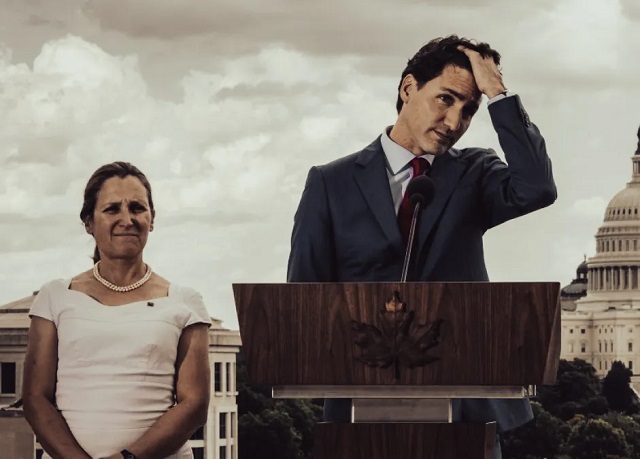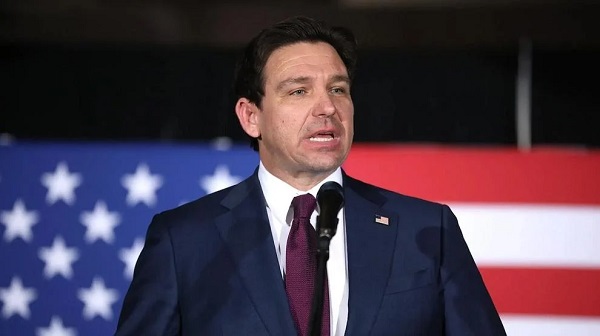Business
The Problem With Trudeau’s Fiscal Responsibility Message

From the Canadian Taxpayers Federation
By Franco Terrazzano
This year’s interest charges will cost taxpayers more than $46 billion. That’s almost $4 billion every month that’s not going to improve services or lower taxes. It’s also a cost of more than $1,000 for every Canadian.
There’s only one problem with the federal government’s messaging about saving money: the feds aren’t actually saving money.
“The foundation of our Fall Economic Statement is our responsible fiscal plan,” said Finance Minister Chrystia Freeland.
The mid-year budget update shows the government increasing spending by $15 billion this year. A far cry from Freeland’s March promise to find “savings of $15.4 billion over the next five years.”
Next year, the government will increase spending by $30 billion. And that comes on top of an already ballooned baseline.
The feds spent all-time highs before the pandemic. That means Prime Minister Justin Trudeau was spending more before the pandemic than the feds did during any single year during World War II, even after accounting for inflation and population growth.
Freeland is trying to put Canadians’ minds at ease by claiming her deficits are “modest.” Canadians have heard this before.
When running for prime minister in 2015, Trudeau promised to run a few “modest” deficits of less than $10 billion before balancing the budget in 2019. Trudeau blew that balanced budget promise by a “modest” $20 billion.
This year’s deficit is projected to hit $40 billion. Deficits in 2024 and 2025 are both projected to be $38 billion.
Is this the new modest? Four times larger than the “modest” deficits Trudeau first promised?
The mid-year budget update proves this government has no idea how to balance a budget.
In fact, the only mention of a balanced budget in Ottawa comes from the Parliamentary Budget Officer, who forecasts the next balanced budget will happen in 2035. But that relies on the economy growing every year, relatively low interest rates and no new spending.
A government too incompetent to balance the budget means Canadians are paying dearly just to service the debt.
This year’s interest charges will cost taxpayers more than $46 billion. That’s almost $4 billion every month that’s not going to improve services or lower taxes. It’s also a cost of more than $1,000 for every Canadian.
Next year, debt interest charges will surpass federal health transfers to the provinces. Soon, every penny collected from the GST will go toward servicing the debt.
As bad as the budget is, the government could keep the ship from sinking with modest spending restraint.
The government could balance the budget next year by using its own projected program spending from two budget updates ago. Instead of running a $38-billion deficit next year, taxpayers would have a $1-billion surplus if Freeland just stuck to the spending plan she created in 2021.
This highlights the root of Trudeau’s spending problem – the ratchet effect. Almost every budget document released by this government drastically increases spending.
The mid-year budget update in 2019 first projected spending in 2024 to be $421 billion. This year’s budget update shows the government will spend $519 billion in 2024.
This government’s muscle for fiscal responsibility has atrophied.
MPs from all political parties can’t help themselves from taking a pay raise every year – regardless of the struggles their constituents endure. The prime minister can’t help but spend $61,000 on Manhattan hotel rooms during a two-day anti-poverty summit.
No one in government is willing to end the hundreds of millions in bureaucratic bonuses, despite departments consistently meeting less than half of their own performance targets.
The Liberals are also unwilling to take the air out of the ballooning bureaucracy, which increased by 98,000 employees since they took power. That’s almost 40 per cent more federal employees. The bureaucracy currently consumes half of every tax dollar used in day-to-day spending.
No party in the House of Commons is willing to oppose the more than $43 billion taxpayers are being forced to give multinational corporations to build battery plants.
This government hasn’t shown one iota of fiscal restraint. In fact, the government appears to be trying its best to run up the red ink. Fortunately for taxpayers, it would only take modest spending restraint for a serious government to bring the books back into black.
Franco Terrazzano is the Federal Director of the Canadian Taxpayers Federation
Business
COP30 finally admits what resource workers already knew: prosperity and lower emissions must go hand in hand

From Resource Works
What a difference a few weeks make
Finally, the Conference of the Parties to the UN climate convention (COP30) adopted a pragmatic tone that will appeal to the working class. Too bad it took thirty meetings. Pragmatism produces results, not missed targets.
We should not have been surprised. Influential figures like Bill Gates and Canadian-Venezuelan analyst Quico Toro, who have long argued that efforts to reduce CO₂ should focus more on technology and prosperity, and less on energy consumption and declining growth, have gained ground.
In the World Energy Outlook 2025, prepared by the International Energy Agency for COP30, you can see that many of the views held by the people above had already gone mainstream before the conference started.
The World Energy Outlook 2025 lays out three scenarios: Current Policies (CPS), Stated Policies (STEPS), and Net Zero Emissions by 2050 (NZE). In WEO 2025, all three scenarios reflect longer timelines for the decline of fossil fuels than in earlier editions, and the NZE pathway explicitly states that major technological breakthroughs will be required.
Unfortunately, many potential technologies are adamantly opposed by the loudest groups within the Climate Change Movement because they are not perfect. Even some continue to oppose nuclear power, one of the few proven sources of large-scale, zero-carbon, firm electricity.
Another noteworthy standout in WEO 2025 was the strong recognition that energy security, costs, and supply chains are now the primary considerations in determining each country’s energy mix.
What all this means is we are breaking away from emotionally charged, fear-based policies and rhetoric and moving toward a practical “let’s do things better” approach.
For 30 years, the radical leadership of the environmental movement has focused on what we should stop doing and on sacrificing prosperity. Essentially, what has been going on is an attack on working people in the industrialized and developing world.
Today, workers in the developed world are so anxious that many are losing faith in democratic institutions. Meanwhile, people in the emerging and developing world see light at the end of the tunnel and are determined to industrialize.
Clearly, it is time to merge the fight to lower CO₂ emissions with prosperity. “Let’s do things better” captures the history of human progress and resonates with working people today.
What does it take for longer, healthier, safer, and more sustainable lives? It takes the pragmatism of workers. They spend their lives striving to improve workplace safety, to develop tools that enable them to perform tasks more effectively with less physical effort, to earn higher pay, to produce more food with less land, and to preserve their opportunity to continue working.
Resource workers have felt under attack and are humiliated when celebrities fly in on a helicopter to denigrate their work and make references to the virtues of small-plot gardening, or politicians who tell them to go back to school for “jobs of the future”, only to find themselves in low-paying service jobs.
As the COP30 discussion indicates, we have reached a turning point. It is time to focus on doing what needs to be done, but doing it better. It is time to stop banning activities entirely as though circumstances and technology never change. Demanding perfection hides what is possible, slows progress and, in some cases, stops it altogether.
Bill Gates’ memo to COP30 points to the turn in the road:
“We should measure success by our impact on human welfare more than our impact on the global temperature, and our success relies on putting energy, health, and agriculture at the centre of our strategies.”
Gates also makes a point that will resonate with working people: “Using more energy is a good thing because it is closely correlated with economic growth.” Ironically, a statement made by a billionaire resonates with working people more than does the message of many climate activists.
The work at the Port of Prince Rupert comes to mind, given its growing role in supplying cleaner cooking and heating fuels, when we are reminded that 2 billion people worldwide cook and/or heat their homes with highly polluting open fires (wood, charcoal, dung, agricultural waste).
Persuasion published Quico Toro’s essay on November 13, 2025, which speaks another truth.
“COP imagines these emissions as something a country’s government can set, like the dial on a thermostat. But emissions are more like GDP: the outcome of a complex process that politicians would like to be able to control, but do not actually control.”
I am feeling more secure about the future here in Canada and BC, as governments, First Nations and the public are leaning into climate and economic pragmatism.
There will be hard discussions and uncomfortable trade-offs. Past decisions need to be re-examined in good faith. Do they meet today’s demands? Are we doing what needs to be done better? Is it the right move for today’s youth and future generations? Will we bring back the hope and opportunity of a growing middle class?
Nobody, not the Liberal government, the BC NDP government, First Nations, none of us would have predicted the world we are facing today, where our economy and sovereignty are challenged.
Today, oil, natural gas, and critical minerals, not one or two but all three, are the financial backstop Canada needs, as we rebuild the economy and secure our sovereignty.
Look West: Jobs and Prosperity for Stronger BC and Canada is as much of an admission that we are falling behind as it is a call to action. Success will take billions of dollars, the exact amount unknown.
But what we do know is that oil, gas, and critical minerals generate the most public revenue, the highest incomes, and are our most significant exports. They are Canada’s bank and comparative advantage. They will provide the cash flow needed to get it done.
Not maximizing oil production and exports is fighting with both hands tied behind our back. We all know it; now we need to focus on doing it better because circumstances have changed dramatically.
Jim Rushton is a 46-year veteran of BC’s resource and transportation sectors, with experience in union representation, economic development, and terminal management.
Resource Works News
Business
Canada’s recent economic growth performance has been awful

From the Fraser Institute
By Ben Eisen and Milagros Palacios
Recently, Statistics Canada released a revision of its calculations of Canada’s gross domestic product (GDP) in recent years. GDP measures the total production in an economy in a given year, and per-person GDP is widely accepted by economists as one of the most useful metrics for assessing quality of life. The new estimate places Canada’s GDP for 2024 at 1.4 per cent larger than previously reported.
By the standards of these sorts of revisions—which are usually quite small—the recent update is significant. But make no mistake, the new numbers do not change the fundamental story of Canada’s economic performance, which has been one of historically weak growth and stagnant living standards for an unusually long stretch of time.
Let’s get into the numbers (all adjusted for inflation, in 2017 dollars) with some historical perspective. The new figures put Canada’s per-person GDP estimate for 2024 at $59,529. By comparison, in 2019 per-person GDP was slightly higher at $59,581. This means there has been no progress at all in Canadian living standards as measured by per-person GDP over the past five years. Even with the revision, five years of flat living standards is an extraordinary result.
This is historically anomalous. From 2000 to 2018—a period that was itself not especially strong by the standards of earlier decades—per-person GDP still grew at a compounded annual rate of just under one per cent. In the 1990s, growth was faster still at roughly 1.8 per cent annually. In both periods, living standards were rising meaningfully, even if the pace varied. The fact that they have completely stagnated for five years is alarming, even if our GDP numbers aren’t quite as bleak as we believed a few weeks ago.
Some pundits determined to view all economic data through a political lens have emphasized that under the new revisions, the overall rate of per-person growth during Justin Trudeau’s time as prime minister is now approximately the same as what occurred during Stephen Harper’s tenure.
However, this is more relevant as a political talking point than an economic insight. The historical data show that at an average annual growth rate of just 0.5 per cent, the Canadian economy’s performance under Harper was weak by long-term standards. This is something that Trudeau himself recognized when he first sought high office, criticizing the Harper government for “having the worst record on economic growth since R.B. Bennett in the depths of the Great Depression.”
Trudeau was right back then that Canadian economic growth during the Harper era was historically weak. As such, a revision showing that Canada’s slow growth has approximately continued for the past decade is hardly cause for celebration. It simply underscores that both governments presided over a long period of weak productivity growth and very slow improvements in living standards—and that in recent years even that sluggish growth has given way to complete stagnation.
Of course, an upward revision to recent GDP calculations is welcome news, but it must not be allowed to distract policymakers or the public from the reality of Canada’s severe long-term growth problem, which in recent years has gone from bad to worse.
-

 Great Reset2 days ago
Great Reset2 days agoViral TikTok video shows 7-year-old cuddling great-grandfather before he’s euthanized
-

 Daily Caller2 days ago
Daily Caller2 days agoChinese Billionaire Tried To Build US-Born Baby Empire As Overseas Elites Turn To American Surrogates
-

 Alberta2 days ago
Alberta2 days agoSchools should go back to basics to mitigate effects of AI
-

 International2 days ago
International2 days agoAt Least 15 Killed In Shooting Targeting Jewish Community At Australia’s Bondi Beach, Police Say
-

 International2 days ago
International2 days agoTwo states designate Muslim group as terrorist
-

 Business2 days ago
Business2 days agoMajor tax changes in 2026: Report
-

 Digital ID1 day ago
Digital ID1 day agoCanada releases new digital ID app for personal documents despite privacy concerns
-

 Bruce Dowbiggin1 day ago
Bruce Dowbiggin1 day agoNFL Ice Bowls Turn Down The Thermostat on Climate Change Hysteria






